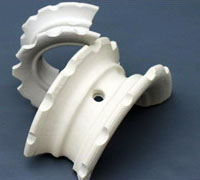Degasifier
Introduction
Atmospheric degasifiers
In water demineralisation, a degasifier, or degasser, is often used to remove dissolved carbon dioxide after cation exchange. The most common degassers are of the so-called forced draft or atmospheric type. One is represented below:
A forced draft degasifier
The water "rains" unto a bed of packing material, and the carbon dioxide is forced to escape to the top of the column by an ascending flow of clean filtered air.


Ceramic saddle shaped and plastic packing examples
Principle and details
After cation exchange, the bicarbonate and carbonate (if any) ions are converted to carbonic acid, or carbon dioxide. CO2 is soluble in water (see graph below), but it tends to escape into the air, much as it does in a glass of Coca-Cola when you stir it. Using a degasser to remove CO2 reduces the ionic load on the strong base anion resin, and the consumption of caustic soda is thus lower.To be effective, the degasifier must be placed after the cation exchange column. Before cation exchange, the water is containing bicarbonate. After it, the cations in water (Ca++, Mg++ and Na+ principally) are converted to H+ ions, which combine with the HCO3— bicarbonate anions to produce carbonic acid (H2CO3 = CO2 + H2O). The reaction details are shown in the page about processes, under demineralisation.
In practice, the water coming out of the cation exchange unit is introduced into a column where it is sprinkled over a bed of filling material, often polypropylene shaped as saddles to leave a maximum volume of voids in the bed. Air is introduced at the bottom of the column by a blower, and escapes at the top, loaded with carbon dioxide from the water.
The solubility of CO2 in pure water is high: about 1.5 g/L or more than 30 meq/L at 25°C and atmospheric pressure (see graph). When you stir the water and divide it into small droplets in an atmospheric degasifier and blow air through the "rain", the gas tends to move into the air because the partial pressure of CO2 in air is much below the equilibrium pressure. The residual CO2 after an atmospheric degasifier is 0.20 to 0.25 meq/L (typically 10 mg/L as CO2. Therefore such degassers are used when the bicarbonate concentration plus free carbon dioxide in the feed water to separate column demineralisation systems is at least 0.6 to 0.8 meq/L.
The forced draft degasifiers are the most common in industrial water treatment, although there are other types of degasifiers, e.g.
- Thermal degassers, allowing to strip oxygen as well as carbon dioxide,
- Vacuum degassers, operating under a vacuum of 1 to 5 kPa for the removal of oxygen
- Membrane degassers, interesting in view of their small size
Membrane degasifiers
For RO permeates with low pH and high free CO2 and for small demineralisation systems, membrane degasifiers can be used. They also remove oxygen, and can be installed horizontally or vertically.








